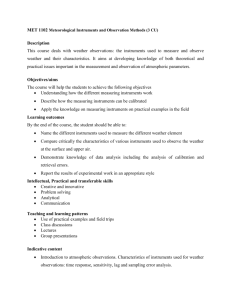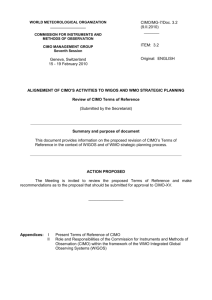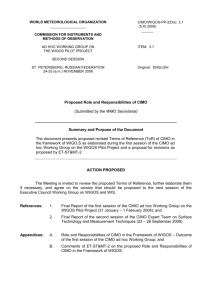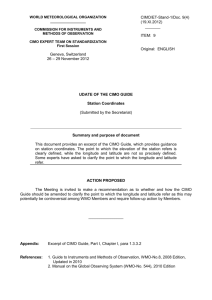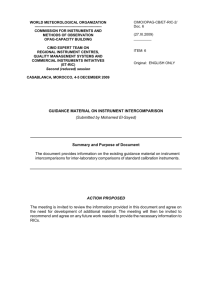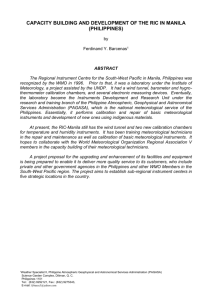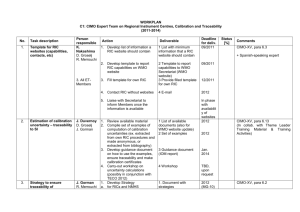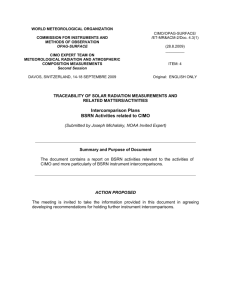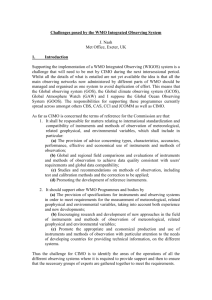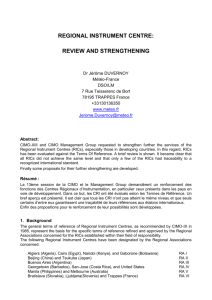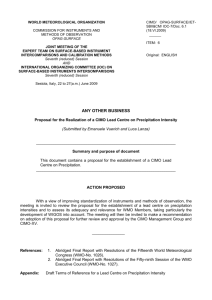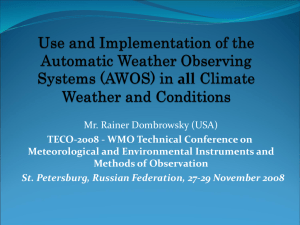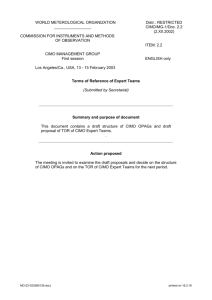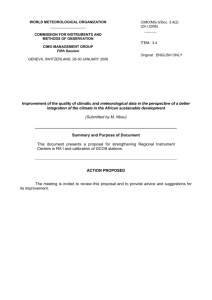SITING CLASSIFICATION OF SURFACE OBSERVING
advertisement
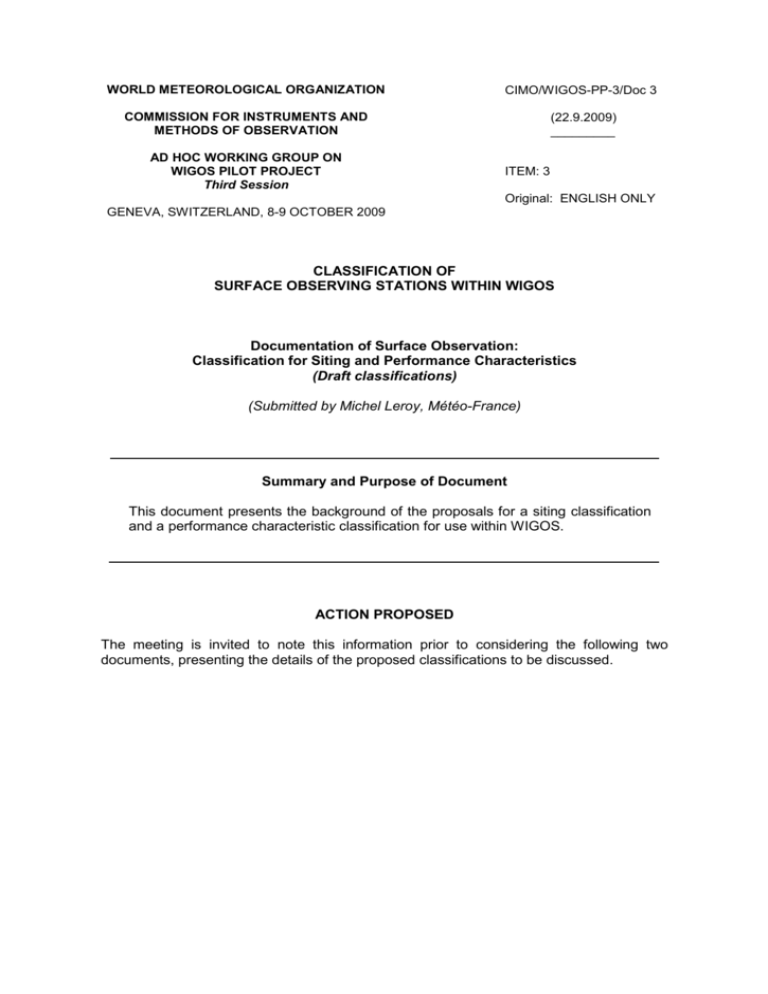
WORLD METEOROLOGICAL ORGANIZATION CIMO/WIGOS-PP-3/Doc 3 COMMISSION FOR INSTRUMENTS AND METHODS OF OBSERVATION (22.9.2009) _________ AD HOC WORKING GROUP ON WIGOS PILOT PROJECT Third Session ITEM: 3 Original: ENGLISH ONLY GENEVA, SWITZERLAND, 8-9 OCTOBER 2009 CLASSIFICATION OF SURFACE OBSERVING STATIONS WITHIN WIGOS Documentation of Surface Observation: Classification for Siting and Performance Characteristics (Draft classifications) (Submitted by Michel Leroy, Météo-France) Summary and Purpose of Document This document presents the background of the proposals for a siting classification and a performance characteristic classification for use within WIGOS. ACTION PROPOSED The meeting is invited to note this information prior to considering the following two documents, presenting the details of the proposed classifications to be discussed. CIMO/WIGOS-PP-3/Doc. 3, p. 2 DOCUMENTATION OF SURFACE OBSERVATION: CLASSIFICATION FOR SITING AND PERFORMANCE CHARACTERISTICS (DRAFT CLASSIFICATION) A primary quality factor of a measurement is the set of “intrinsic” characteristics of the equipment used. INTRODUCTION Metadata are necessary to use the measurements. The minimum set of metadata is the location of the measurement site! Additional information is the type of instruments used, their characteristics, calibration facts, the environment of the station, etc. See for example the Manual of GOS and annexes 5 and 6 of the final report of the Expert Team on requirements for data from Automatic Weather Stations ET/AWS4. Concerning the site environment and the sensors used, it is obviously possible and recommended to fully document the site, the instruments, each calibration value, etc. But the danger is that a fully documentation of all these aspects would stay a target never reached and that the complexity of detailed metadata would often restrict their operational use. That is why classifications are defined to condense the information and facilitate the operational use of this metadata information. These classifications are based on the following analysis of the quality factors affecting a measurement. QUALITY OF A MEASUREMENT Quality is the ability to satisfy implicit or explicit needs. For meteorological measurements, this is often translated to a statement of operational accuracy requirements. Several factors have an influence on the « quality » of a measurement; we consider here the following list: a) The intrinsic characteristics of sensors or measurement methods. They are coming from technical specifications, emitted by technical services, users or manufacturers. These characteristics are commonly described by the manufacturers, sometimes controlled during intercomparisons and are generally well known and mastered, at least for the classic measurements which we are dealing with. b) The maintenance tasks (including calibration) needed to maintain the system in nominal conditions. These operations are often expensive and need a continuous effort. Preventive maintenance is the best guaranty to maintain a system close to its nominal performance, allowing final measurements to be close to the « intrinsic » performances of the sensor. Experience shows that this maintenance is not always well mastered, therefore the maintenance organization has to be considered with the intrinsic characteristics of the instrument to really evaluate the operational measurement performances. c) The site representativeness. This representativeness is sometimes neglected, especially when the density of a network is increasing. People selecting a site know the exposure rules, but numerous logistic constraints exist. For cost and availability considerations, the measurement system may be hosted on a site not belonging to the owner (or the administrator) of the network. The access to the site, its supervision and the availability of transmission and power lines are important elements. These logistic aspects, combined to the orography, may surpass the strict application of exposure rules, quite restricting. A compromise is often selected. But when the rules are not applied, there may be no limits. Who have not ever seen anemometers close to high trees? CIMO/WIGOS-PP-3/Doc. 3, p. 3 CLASSIFICATIONS SITING CLASSIFICATION In 1998, Météo-France defined a classification for some basic surface variables to document the nearby environment of a site. This classification was the basis of the proposed WMO classification. This classification ranges from 1 to 5. By convention, a class 1 site follows the WMO recommendations. A class 5 site is a site where nearby obstacles create an inappropriate environment for a meteorological measurement representative of a large area and where measurements should be avoided. For some classes, an estimation of the possible associated errors or perturbations is indicated. A classification is defined for air temperature measurement, relative humidity, wind, precipitation and solar radiation. This classification is presented in a separate document. MAINTAINED PERFORMANCE The “intrinsic” characteristics of an instrument are known from the manufacturer documentation and/or from laboratory or field tests. The statement of required and achievable measurement uncertainty is given in Chapter 1 of WMO-No. 8 (Guide to Meteorological Instruments and Methods of Observation). When writing technical specifications to buy an equipment, it is necessary to have in mind the achievable measurement uncertainty, recognizing also that even requesting (only) the state of the art achievable uncertainty may result in high costs and/or some exaggeration of their instrument performances from some manufacturers. Therefore, it is highly recommended to be aware of the possible performances (with associated costs) before issuing technical specifications. Test reports and intercomparison reports of instruments are very valuable tools to specify and select an instrument with objective information. Once an instrument is selected and its performance characteristics known, it is necessary to maintain the level of performance during its operational period. Preventive maintenance and calibration are therefore necessary and must be identified to maintain the desired measurement uncertainty. It is possible to combine the characteristics of an instrument and the maintenance organization applied to maintain the performance in another classification, called "maintained performance classification", including the uncertainty of the instrument and the periodicity of preventive maintenance and calibration. This classification ranges from A (instrument following the WMO/CIMO recommendations, in particular table in chapter 1 of the CIMO Guide) to D (no maintenance and calibration organized), with an additional class E for unknown characteristics and maintenance. Class B and C are for instruments and maintenance/calibration procedures less stringent than for class A. This classification is related to a network, considering the instruments used and the maintenance organization applied for this network. So, it is an “organization” classification. It doesn’t give the information of what has been made on a particular day on a particular site. This classification covers the quality factors a) and b) listed above. It is presented in a separate document. CONCLUSION With these two classifications, a letter and a number therefore describe a measurement on a given site. For example: C3 for global solar radiation is for a class 2 pyranometer without ventilation, calibrated every 2 years, installed on a site with direct obstructions, but below 7°. These classifications are intended to describe the real world of measuring networks, which is sometimes far from the WMO/CIMO recommendations. It is difficult to condense information so much, but this helps the end users to really get and use these metadata information. Experience shows also that the classification process forces the network manager to analyze his practices, often leading to an improvement of this network. Obviously, using these classifications doesn’t restrict a much more detailed documentation of the site and the instruments.




